Mobile Medical Clinics: A Review of Healthcare Delivery in Rural India
VerifiedAdded on 2023/06/11
|48
|14985
|219
Literature Review
AI Summary
This literature review examines the efficacy of mobile medical clinics (MMC) in improving healthcare access in rural settings, particularly in the context of India. It addresses the challenges faced by rural populations in accessing healthcare services due to distance, lack of health literacy, and cultural barriers. The review employs a systematic approach, guided by PRISMA guidelines, to evaluate the ability of MMCs to improve healthcare quality, reduce mortality rates, and alleviate the burden of disease. The findings indicate that while distance remains a significant obstacle, MMCs demonstrate success in disease screening, early identification of chronic disease risks, and increasing the acceptability of healthcare services. The review highlights the potential of MMCs to address health disparities and provide essential primary healthcare services to underserved rural communities, offering insights into their role in disease prevention and management.
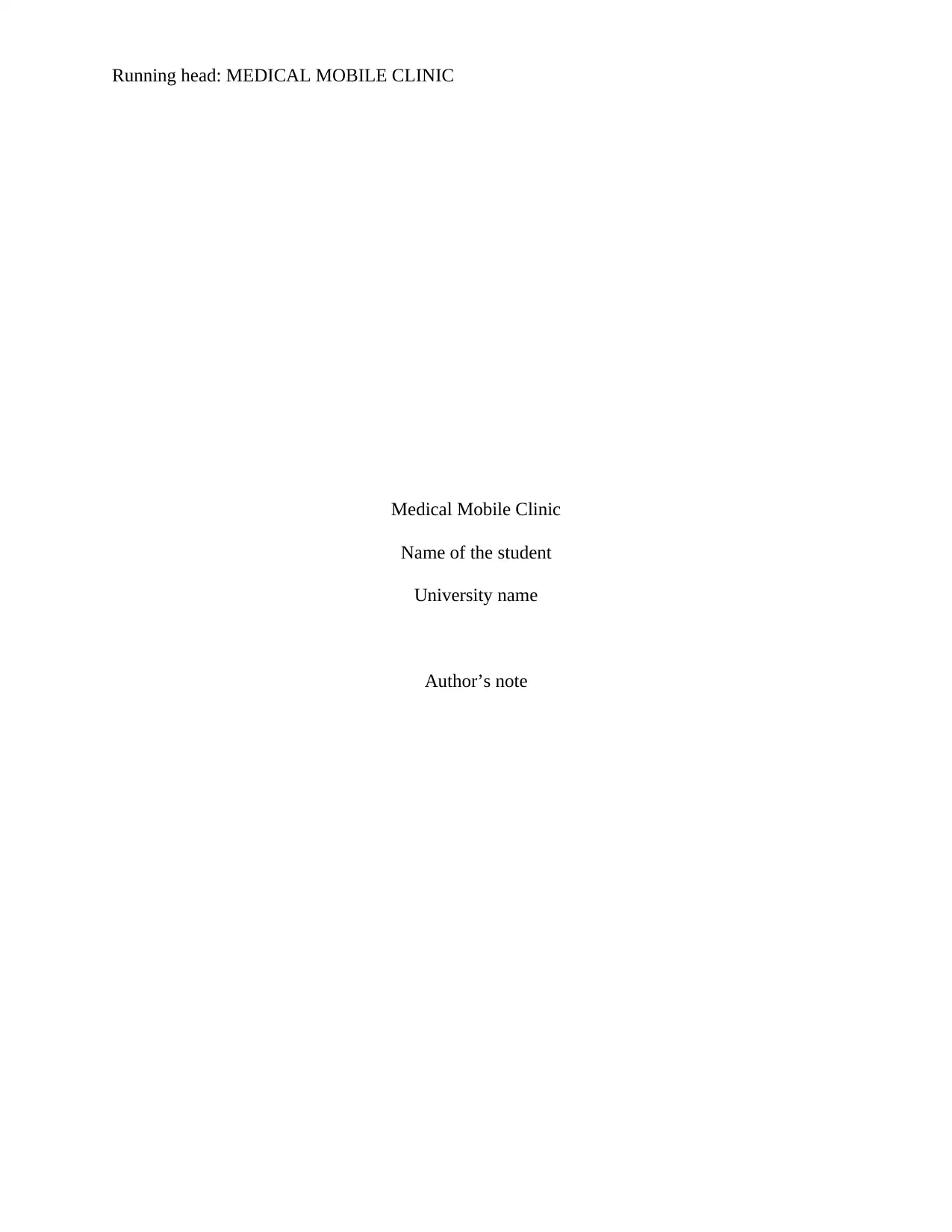
Running head: MEDICAL MOBILE CLINIC
Medical Mobile Clinic
Name of the student
University name
Author’s note
Medical Mobile Clinic
Name of the student
University name
Author’s note
Paraphrase This Document
Need a fresh take? Get an instant paraphrase of this document with our AI Paraphraser
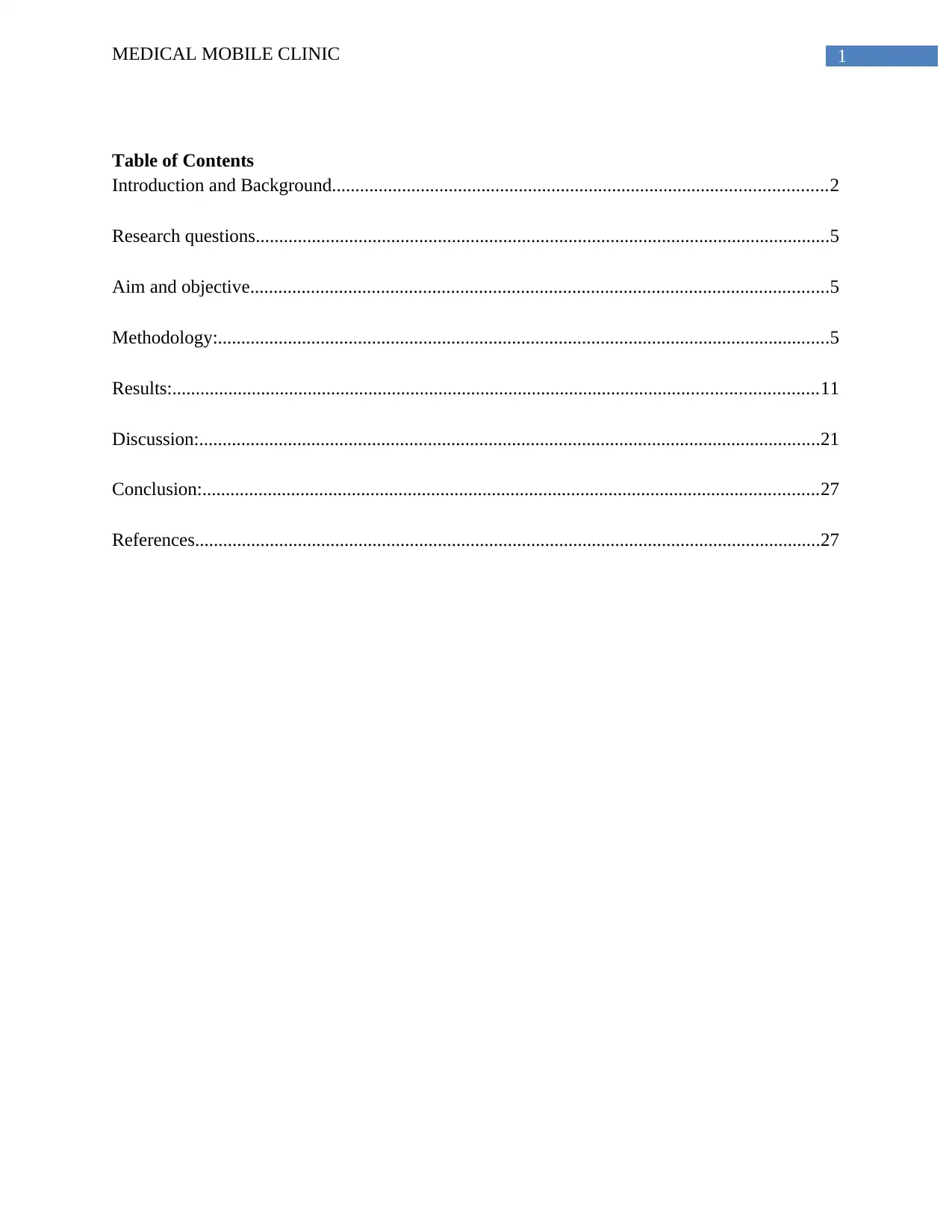
1MEDICAL MOBILE CLINIC
Table of Contents
Introduction and Background..........................................................................................................2
Research questions...........................................................................................................................5
Aim and objective............................................................................................................................5
Methodology:...................................................................................................................................5
Results:..........................................................................................................................................11
Discussion:.....................................................................................................................................21
Conclusion:....................................................................................................................................27
References......................................................................................................................................27
Table of Contents
Introduction and Background..........................................................................................................2
Research questions...........................................................................................................................5
Aim and objective............................................................................................................................5
Methodology:...................................................................................................................................5
Results:..........................................................................................................................................11
Discussion:.....................................................................................................................................21
Conclusion:....................................................................................................................................27
References......................................................................................................................................27
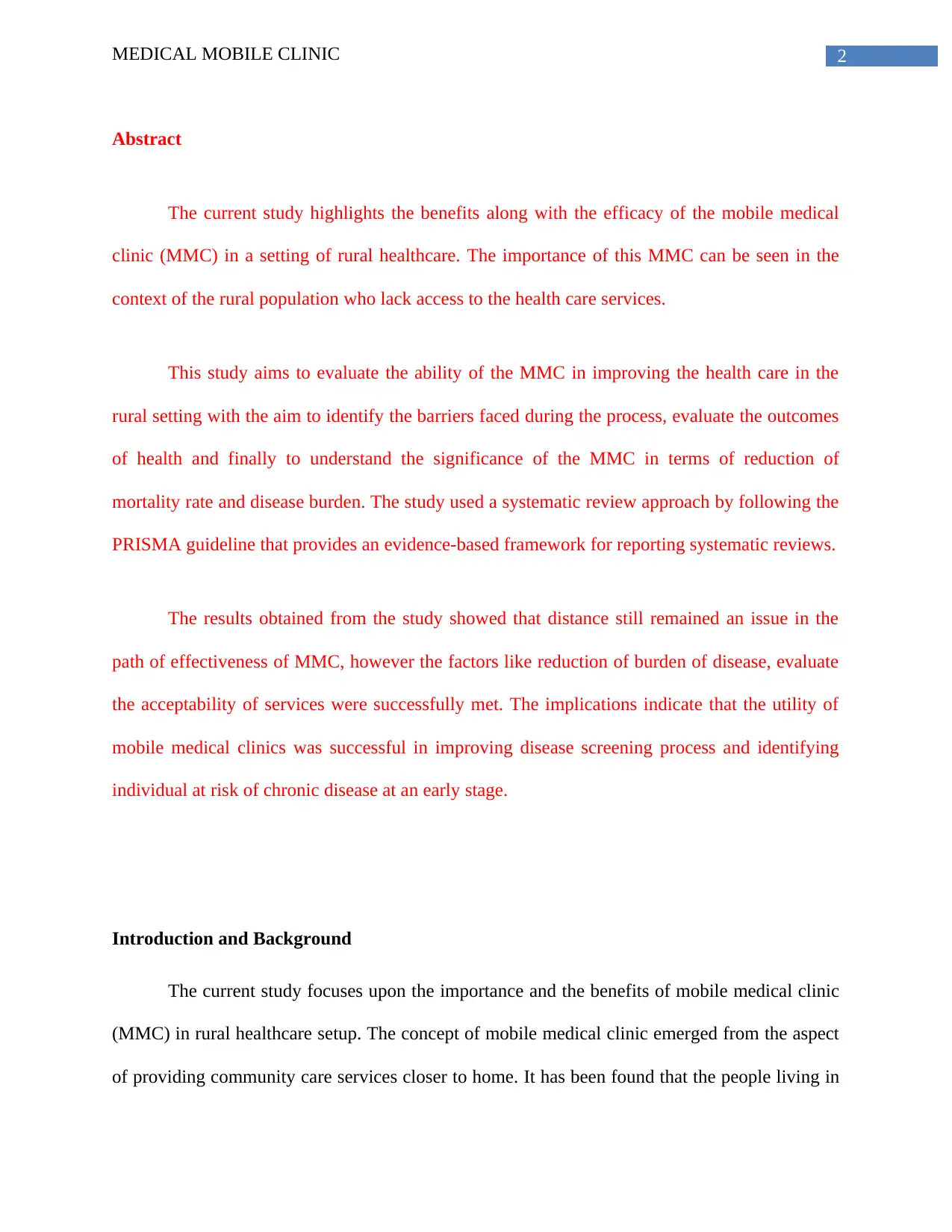
2MEDICAL MOBILE CLINIC
Abstract
The current study highlights the benefits along with the efficacy of the mobile medical
clinic (MMC) in a setting of rural healthcare. The importance of this MMC can be seen in the
context of the rural population who lack access to the health care services.
This study aims to evaluate the ability of the MMC in improving the health care in the
rural setting with the aim to identify the barriers faced during the process, evaluate the outcomes
of health and finally to understand the significance of the MMC in terms of reduction of
mortality rate and disease burden. The study used a systematic review approach by following the
PRISMA guideline that provides an evidence-based framework for reporting systematic reviews.
The results obtained from the study showed that distance still remained an issue in the
path of effectiveness of MMC, however the factors like reduction of burden of disease, evaluate
the acceptability of services were successfully met. The implications indicate that the utility of
mobile medical clinics was successful in improving disease screening process and identifying
individual at risk of chronic disease at an early stage.
Introduction and Background
The current study focuses upon the importance and the benefits of mobile medical clinic
(MMC) in rural healthcare setup. The concept of mobile medical clinic emerged from the aspect
of providing community care services closer to home. It has been found that the people living in
Abstract
The current study highlights the benefits along with the efficacy of the mobile medical
clinic (MMC) in a setting of rural healthcare. The importance of this MMC can be seen in the
context of the rural population who lack access to the health care services.
This study aims to evaluate the ability of the MMC in improving the health care in the
rural setting with the aim to identify the barriers faced during the process, evaluate the outcomes
of health and finally to understand the significance of the MMC in terms of reduction of
mortality rate and disease burden. The study used a systematic review approach by following the
PRISMA guideline that provides an evidence-based framework for reporting systematic reviews.
The results obtained from the study showed that distance still remained an issue in the
path of effectiveness of MMC, however the factors like reduction of burden of disease, evaluate
the acceptability of services were successfully met. The implications indicate that the utility of
mobile medical clinics was successful in improving disease screening process and identifying
individual at risk of chronic disease at an early stage.
Introduction and Background
The current study focuses upon the importance and the benefits of mobile medical clinic
(MMC) in rural healthcare setup. The concept of mobile medical clinic emerged from the aspect
of providing community care services closer to home. It has been found that the people living in
⊘ This is a preview!⊘
Do you want full access?
Subscribe today to unlock all pages.

Trusted by 1+ million students worldwide
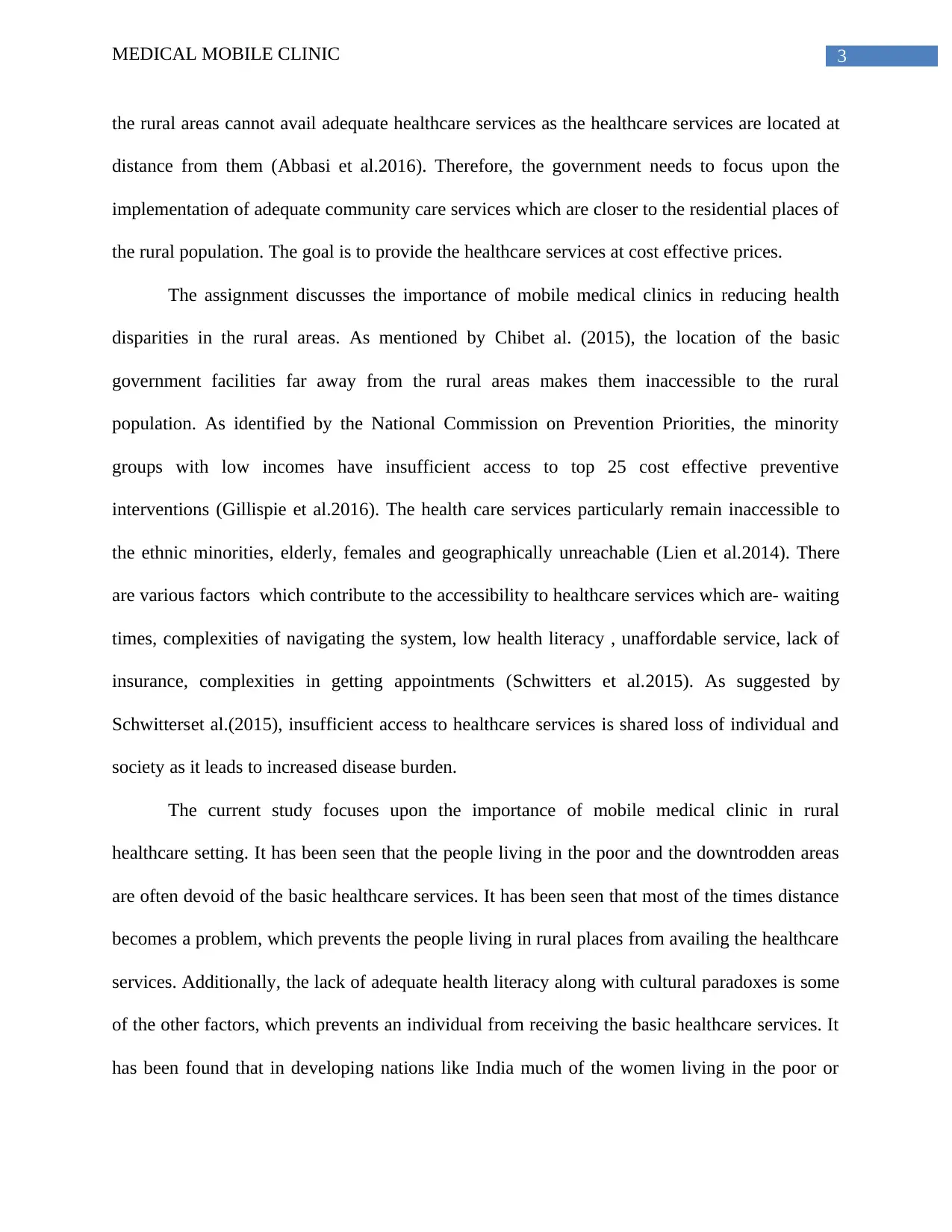
3MEDICAL MOBILE CLINIC
the rural areas cannot avail adequate healthcare services as the healthcare services are located at
distance from them (Abbasi et al.2016). Therefore, the government needs to focus upon the
implementation of adequate community care services which are closer to the residential places of
the rural population. The goal is to provide the healthcare services at cost effective prices.
The assignment discusses the importance of mobile medical clinics in reducing health
disparities in the rural areas. As mentioned by Chibet al. (2015), the location of the basic
government facilities far away from the rural areas makes them inaccessible to the rural
population. As identified by the National Commission on Prevention Priorities, the minority
groups with low incomes have insufficient access to top 25 cost effective preventive
interventions (Gillispie et al.2016). The health care services particularly remain inaccessible to
the ethnic minorities, elderly, females and geographically unreachable (Lien et al.2014). There
are various factors which contribute to the accessibility to healthcare services which are- waiting
times, complexities of navigating the system, low health literacy , unaffordable service, lack of
insurance, complexities in getting appointments (Schwitters et al.2015). As suggested by
Schwitterset al.(2015), insufficient access to healthcare services is shared loss of individual and
society as it leads to increased disease burden.
The current study focuses upon the importance of mobile medical clinic in rural
healthcare setting. It has been seen that the people living in the poor and the downtrodden areas
are often devoid of the basic healthcare services. It has been seen that most of the times distance
becomes a problem, which prevents the people living in rural places from availing the healthcare
services. Additionally, the lack of adequate health literacy along with cultural paradoxes is some
of the other factors, which prevents an individual from receiving the basic healthcare services. It
has been found that in developing nations like India much of the women living in the poor or
the rural areas cannot avail adequate healthcare services as the healthcare services are located at
distance from them (Abbasi et al.2016). Therefore, the government needs to focus upon the
implementation of adequate community care services which are closer to the residential places of
the rural population. The goal is to provide the healthcare services at cost effective prices.
The assignment discusses the importance of mobile medical clinics in reducing health
disparities in the rural areas. As mentioned by Chibet al. (2015), the location of the basic
government facilities far away from the rural areas makes them inaccessible to the rural
population. As identified by the National Commission on Prevention Priorities, the minority
groups with low incomes have insufficient access to top 25 cost effective preventive
interventions (Gillispie et al.2016). The health care services particularly remain inaccessible to
the ethnic minorities, elderly, females and geographically unreachable (Lien et al.2014). There
are various factors which contribute to the accessibility to healthcare services which are- waiting
times, complexities of navigating the system, low health literacy , unaffordable service, lack of
insurance, complexities in getting appointments (Schwitters et al.2015). As suggested by
Schwitterset al.(2015), insufficient access to healthcare services is shared loss of individual and
society as it leads to increased disease burden.
The current study focuses upon the importance of mobile medical clinic in rural
healthcare setting. It has been seen that the people living in the poor and the downtrodden areas
are often devoid of the basic healthcare services. It has been seen that most of the times distance
becomes a problem, which prevents the people living in rural places from availing the healthcare
services. Additionally, the lack of adequate health literacy along with cultural paradoxes is some
of the other factors, which prevents an individual from receiving the basic healthcare services. It
has been found that in developing nations like India much of the women living in the poor or
Paraphrase This Document
Need a fresh take? Get an instant paraphrase of this document with our AI Paraphraser
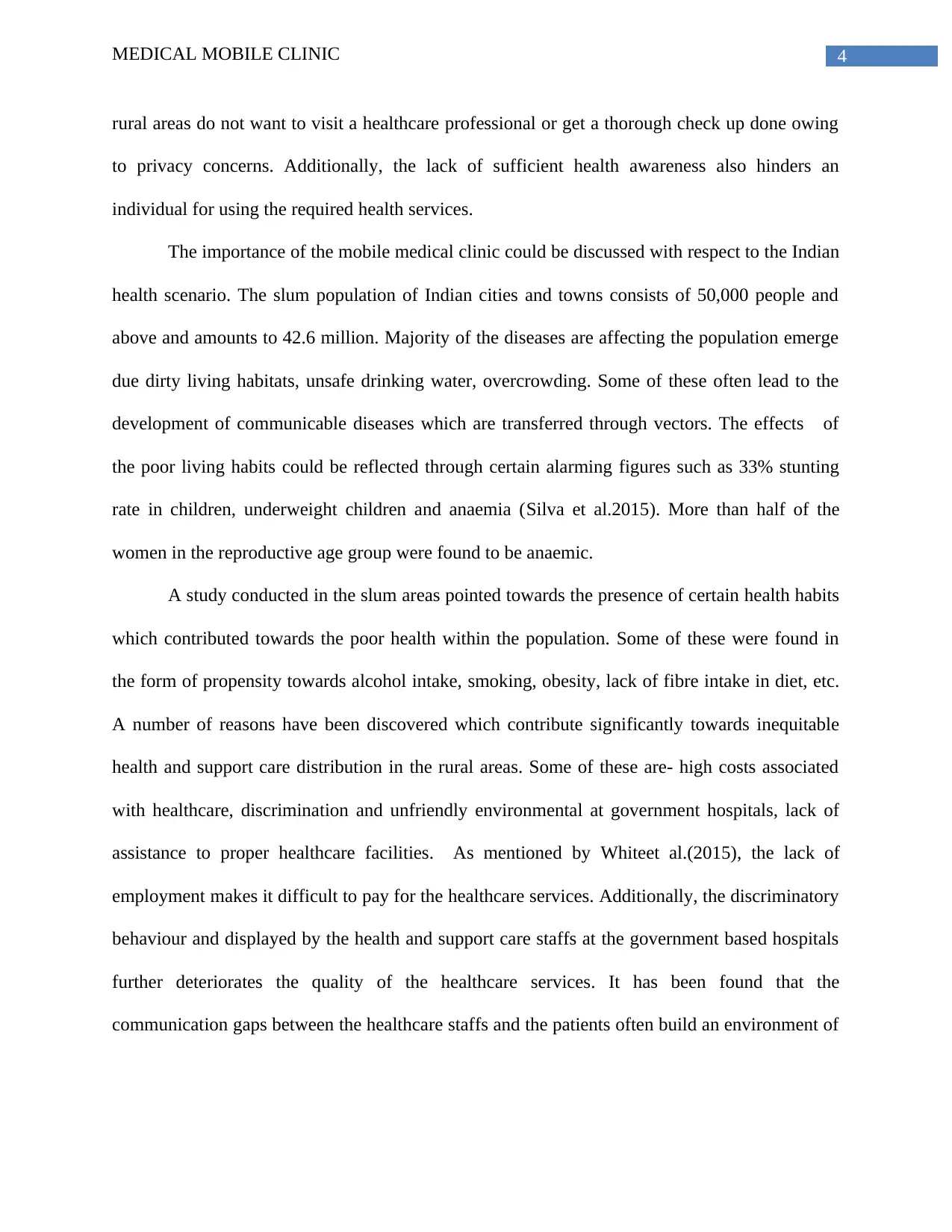
4MEDICAL MOBILE CLINIC
rural areas do not want to visit a healthcare professional or get a thorough check up done owing
to privacy concerns. Additionally, the lack of sufficient health awareness also hinders an
individual for using the required health services.
The importance of the mobile medical clinic could be discussed with respect to the Indian
health scenario. The slum population of Indian cities and towns consists of 50,000 people and
above and amounts to 42.6 million. Majority of the diseases are affecting the population emerge
due dirty living habitats, unsafe drinking water, overcrowding. Some of these often lead to the
development of communicable diseases which are transferred through vectors. The effects of
the poor living habits could be reflected through certain alarming figures such as 33% stunting
rate in children, underweight children and anaemia (Silva et al.2015). More than half of the
women in the reproductive age group were found to be anaemic.
A study conducted in the slum areas pointed towards the presence of certain health habits
which contributed towards the poor health within the population. Some of these were found in
the form of propensity towards alcohol intake, smoking, obesity, lack of fibre intake in diet, etc.
A number of reasons have been discovered which contribute significantly towards inequitable
health and support care distribution in the rural areas. Some of these are- high costs associated
with healthcare, discrimination and unfriendly environmental at government hospitals, lack of
assistance to proper healthcare facilities. As mentioned by Whiteet al.(2015), the lack of
employment makes it difficult to pay for the healthcare services. Additionally, the discriminatory
behaviour and displayed by the health and support care staffs at the government based hospitals
further deteriorates the quality of the healthcare services. It has been found that the
communication gaps between the healthcare staffs and the patients often build an environment of
rural areas do not want to visit a healthcare professional or get a thorough check up done owing
to privacy concerns. Additionally, the lack of sufficient health awareness also hinders an
individual for using the required health services.
The importance of the mobile medical clinic could be discussed with respect to the Indian
health scenario. The slum population of Indian cities and towns consists of 50,000 people and
above and amounts to 42.6 million. Majority of the diseases are affecting the population emerge
due dirty living habitats, unsafe drinking water, overcrowding. Some of these often lead to the
development of communicable diseases which are transferred through vectors. The effects of
the poor living habits could be reflected through certain alarming figures such as 33% stunting
rate in children, underweight children and anaemia (Silva et al.2015). More than half of the
women in the reproductive age group were found to be anaemic.
A study conducted in the slum areas pointed towards the presence of certain health habits
which contributed towards the poor health within the population. Some of these were found in
the form of propensity towards alcohol intake, smoking, obesity, lack of fibre intake in diet, etc.
A number of reasons have been discovered which contribute significantly towards inequitable
health and support care distribution in the rural areas. Some of these are- high costs associated
with healthcare, discrimination and unfriendly environmental at government hospitals, lack of
assistance to proper healthcare facilities. As mentioned by Whiteet al.(2015), the lack of
employment makes it difficult to pay for the healthcare services. Additionally, the discriminatory
behaviour and displayed by the health and support care staffs at the government based hospitals
further deteriorates the quality of the healthcare services. It has been found that the
communication gaps between the healthcare staffs and the patients often build an environment of
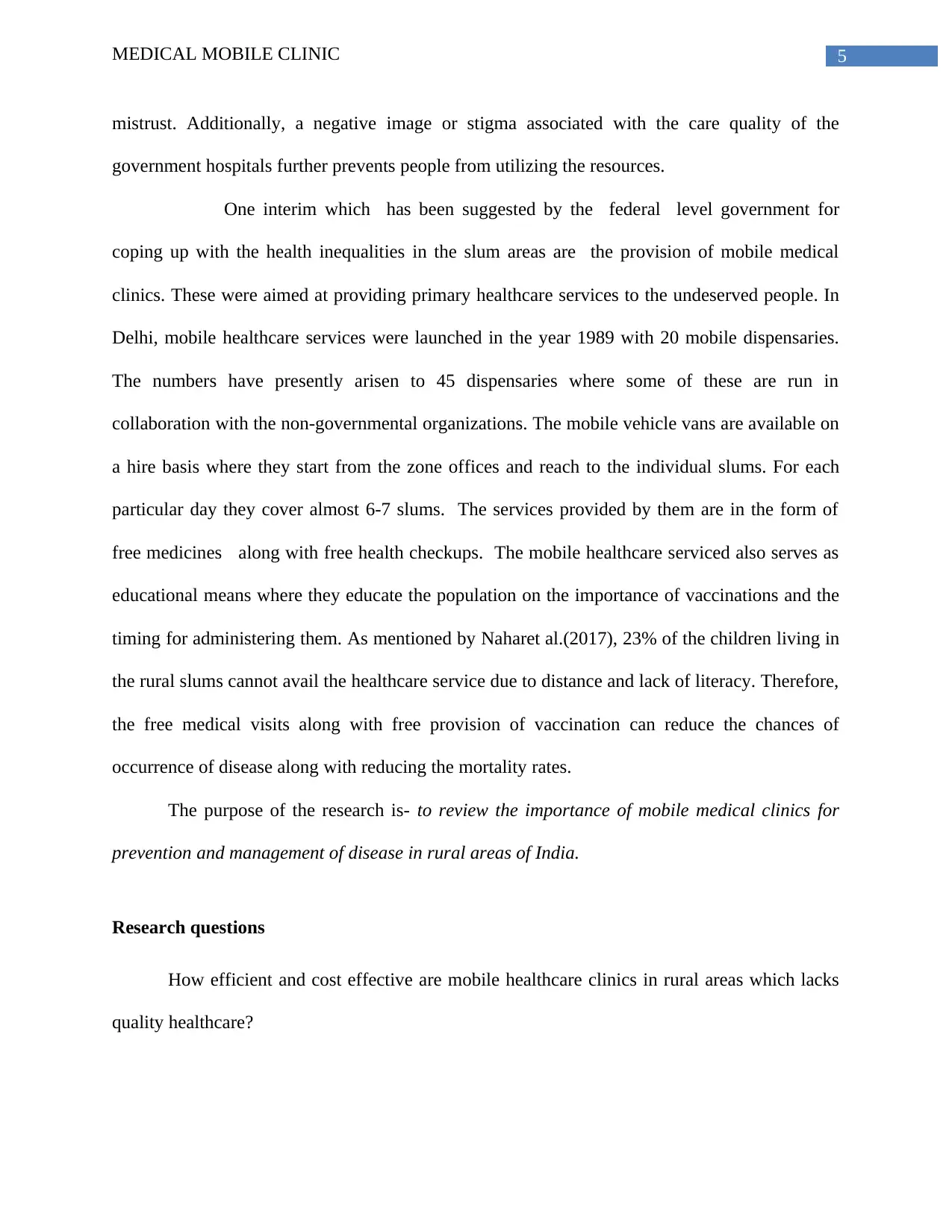
5MEDICAL MOBILE CLINIC
mistrust. Additionally, a negative image or stigma associated with the care quality of the
government hospitals further prevents people from utilizing the resources.
One interim which has been suggested by the federal level government for
coping up with the health inequalities in the slum areas are the provision of mobile medical
clinics. These were aimed at providing primary healthcare services to the undeserved people. In
Delhi, mobile healthcare services were launched in the year 1989 with 20 mobile dispensaries.
The numbers have presently arisen to 45 dispensaries where some of these are run in
collaboration with the non-governmental organizations. The mobile vehicle vans are available on
a hire basis where they start from the zone offices and reach to the individual slums. For each
particular day they cover almost 6-7 slums. The services provided by them are in the form of
free medicines along with free health checkups. The mobile healthcare serviced also serves as
educational means where they educate the population on the importance of vaccinations and the
timing for administering them. As mentioned by Naharet al.(2017), 23% of the children living in
the rural slums cannot avail the healthcare service due to distance and lack of literacy. Therefore,
the free medical visits along with free provision of vaccination can reduce the chances of
occurrence of disease along with reducing the mortality rates.
The purpose of the research is- to review the importance of mobile medical clinics for
prevention and management of disease in rural areas of India.
Research questions
How efficient and cost effective are mobile healthcare clinics in rural areas which lacks
quality healthcare?
mistrust. Additionally, a negative image or stigma associated with the care quality of the
government hospitals further prevents people from utilizing the resources.
One interim which has been suggested by the federal level government for
coping up with the health inequalities in the slum areas are the provision of mobile medical
clinics. These were aimed at providing primary healthcare services to the undeserved people. In
Delhi, mobile healthcare services were launched in the year 1989 with 20 mobile dispensaries.
The numbers have presently arisen to 45 dispensaries where some of these are run in
collaboration with the non-governmental organizations. The mobile vehicle vans are available on
a hire basis where they start from the zone offices and reach to the individual slums. For each
particular day they cover almost 6-7 slums. The services provided by them are in the form of
free medicines along with free health checkups. The mobile healthcare serviced also serves as
educational means where they educate the population on the importance of vaccinations and the
timing for administering them. As mentioned by Naharet al.(2017), 23% of the children living in
the rural slums cannot avail the healthcare service due to distance and lack of literacy. Therefore,
the free medical visits along with free provision of vaccination can reduce the chances of
occurrence of disease along with reducing the mortality rates.
The purpose of the research is- to review the importance of mobile medical clinics for
prevention and management of disease in rural areas of India.
Research questions
How efficient and cost effective are mobile healthcare clinics in rural areas which lacks
quality healthcare?
⊘ This is a preview!⊘
Do you want full access?
Subscribe today to unlock all pages.

Trusted by 1+ million students worldwide
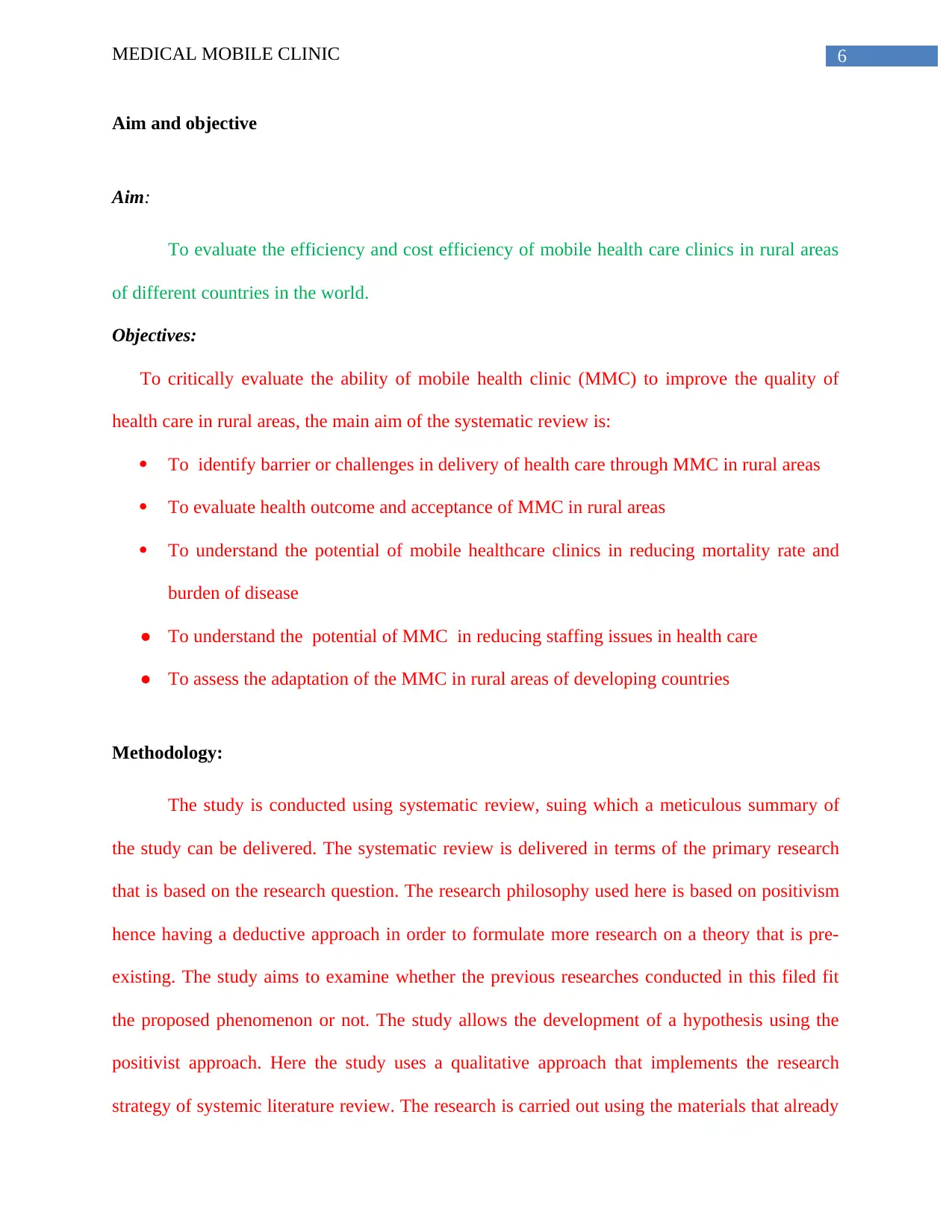
6MEDICAL MOBILE CLINIC
Aim and objective
Aim:
To evaluate the efficiency and cost efficiency of mobile health care clinics in rural areas
of different countries in the world.
Objectives:
To critically evaluate the ability of mobile health clinic (MMC) to improve the quality of
health care in rural areas, the main aim of the systematic review is:
To identify barrier or challenges in delivery of health care through MMC in rural areas
To evaluate health outcome and acceptance of MMC in rural areas
To understand the potential of mobile healthcare clinics in reducing mortality rate and
burden of disease
● To understand the potential of MMC in reducing staffing issues in health care
● To assess the adaptation of the MMC in rural areas of developing countries
Methodology:
The study is conducted using systematic review, suing which a meticulous summary of
the study can be delivered. The systematic review is delivered in terms of the primary research
that is based on the research question. The research philosophy used here is based on positivism
hence having a deductive approach in order to formulate more research on a theory that is pre-
existing. The study aims to examine whether the previous researches conducted in this filed fit
the proposed phenomenon or not. The study allows the development of a hypothesis using the
positivist approach. Here the study uses a qualitative approach that implements the research
strategy of systemic literature review. The research is carried out using the materials that already
Aim and objective
Aim:
To evaluate the efficiency and cost efficiency of mobile health care clinics in rural areas
of different countries in the world.
Objectives:
To critically evaluate the ability of mobile health clinic (MMC) to improve the quality of
health care in rural areas, the main aim of the systematic review is:
To identify barrier or challenges in delivery of health care through MMC in rural areas
To evaluate health outcome and acceptance of MMC in rural areas
To understand the potential of mobile healthcare clinics in reducing mortality rate and
burden of disease
● To understand the potential of MMC in reducing staffing issues in health care
● To assess the adaptation of the MMC in rural areas of developing countries
Methodology:
The study is conducted using systematic review, suing which a meticulous summary of
the study can be delivered. The systematic review is delivered in terms of the primary research
that is based on the research question. The research philosophy used here is based on positivism
hence having a deductive approach in order to formulate more research on a theory that is pre-
existing. The study aims to examine whether the previous researches conducted in this filed fit
the proposed phenomenon or not. The study allows the development of a hypothesis using the
positivist approach. Here the study uses a qualitative approach that implements the research
strategy of systemic literature review. The research is carried out using the materials that already
Paraphrase This Document
Need a fresh take? Get an instant paraphrase of this document with our AI Paraphraser
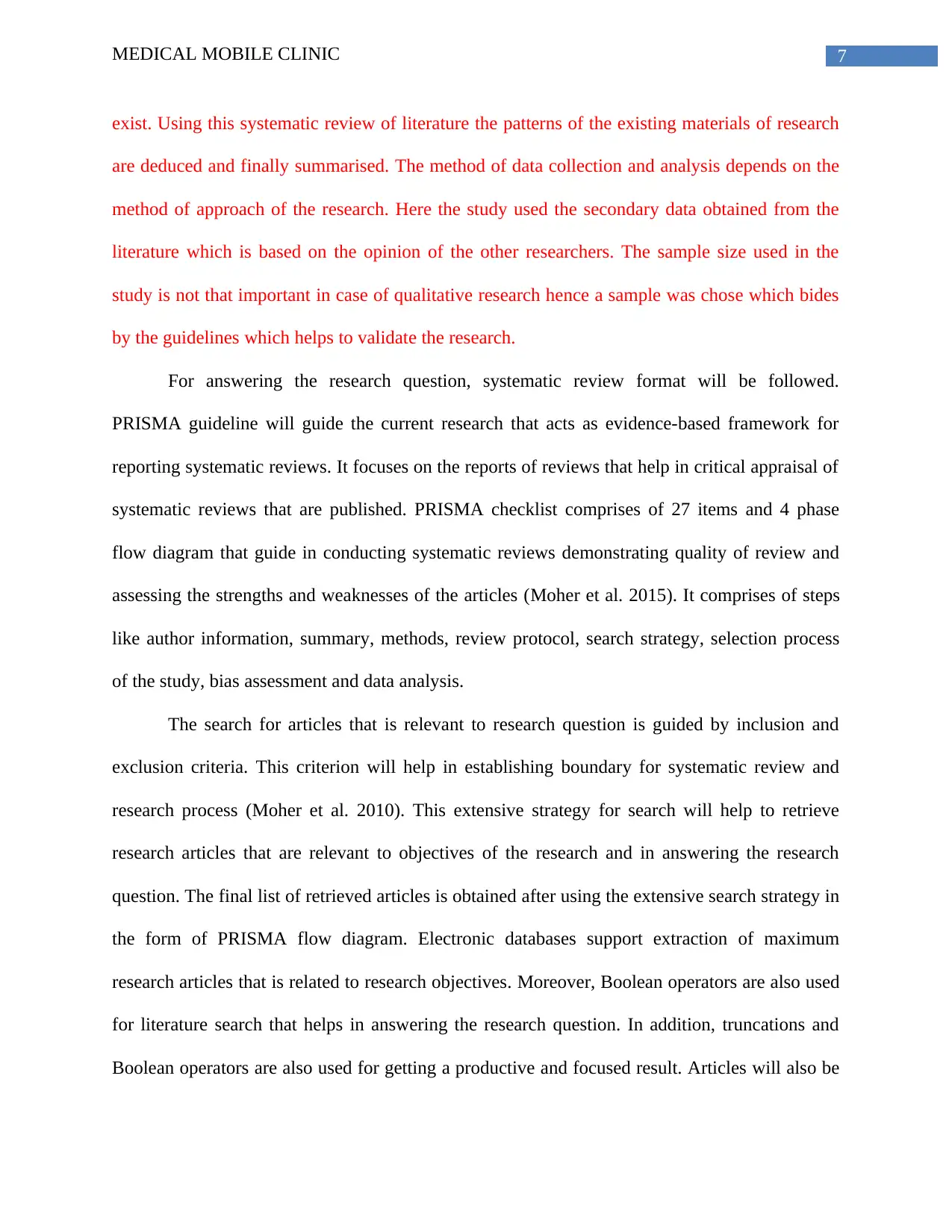
7MEDICAL MOBILE CLINIC
exist. Using this systematic review of literature the patterns of the existing materials of research
are deduced and finally summarised. The method of data collection and analysis depends on the
method of approach of the research. Here the study used the secondary data obtained from the
literature which is based on the opinion of the other researchers. The sample size used in the
study is not that important in case of qualitative research hence a sample was chose which bides
by the guidelines which helps to validate the research.
For answering the research question, systematic review format will be followed.
PRISMA guideline will guide the current research that acts as evidence-based framework for
reporting systematic reviews. It focuses on the reports of reviews that help in critical appraisal of
systematic reviews that are published. PRISMA checklist comprises of 27 items and 4 phase
flow diagram that guide in conducting systematic reviews demonstrating quality of review and
assessing the strengths and weaknesses of the articles (Moher et al. 2015). It comprises of steps
like author information, summary, methods, review protocol, search strategy, selection process
of the study, bias assessment and data analysis.
The search for articles that is relevant to research question is guided by inclusion and
exclusion criteria. This criterion will help in establishing boundary for systematic review and
research process (Moher et al. 2010). This extensive strategy for search will help to retrieve
research articles that are relevant to objectives of the research and in answering the research
question. The final list of retrieved articles is obtained after using the extensive search strategy in
the form of PRISMA flow diagram. Electronic databases support extraction of maximum
research articles that is related to research objectives. Moreover, Boolean operators are also used
for literature search that helps in answering the research question. In addition, truncations and
Boolean operators are also used for getting a productive and focused result. Articles will also be
exist. Using this systematic review of literature the patterns of the existing materials of research
are deduced and finally summarised. The method of data collection and analysis depends on the
method of approach of the research. Here the study used the secondary data obtained from the
literature which is based on the opinion of the other researchers. The sample size used in the
study is not that important in case of qualitative research hence a sample was chose which bides
by the guidelines which helps to validate the research.
For answering the research question, systematic review format will be followed.
PRISMA guideline will guide the current research that acts as evidence-based framework for
reporting systematic reviews. It focuses on the reports of reviews that help in critical appraisal of
systematic reviews that are published. PRISMA checklist comprises of 27 items and 4 phase
flow diagram that guide in conducting systematic reviews demonstrating quality of review and
assessing the strengths and weaknesses of the articles (Moher et al. 2015). It comprises of steps
like author information, summary, methods, review protocol, search strategy, selection process
of the study, bias assessment and data analysis.
The search for articles that is relevant to research question is guided by inclusion and
exclusion criteria. This criterion will help in establishing boundary for systematic review and
research process (Moher et al. 2010). This extensive strategy for search will help to retrieve
research articles that are relevant to objectives of the research and in answering the research
question. The final list of retrieved articles is obtained after using the extensive search strategy in
the form of PRISMA flow diagram. Electronic databases support extraction of maximum
research articles that is related to research objectives. Moreover, Boolean operators are also used
for literature search that helps in answering the research question. In addition, truncations and
Boolean operators are also used for getting a productive and focused result. Articles will also be
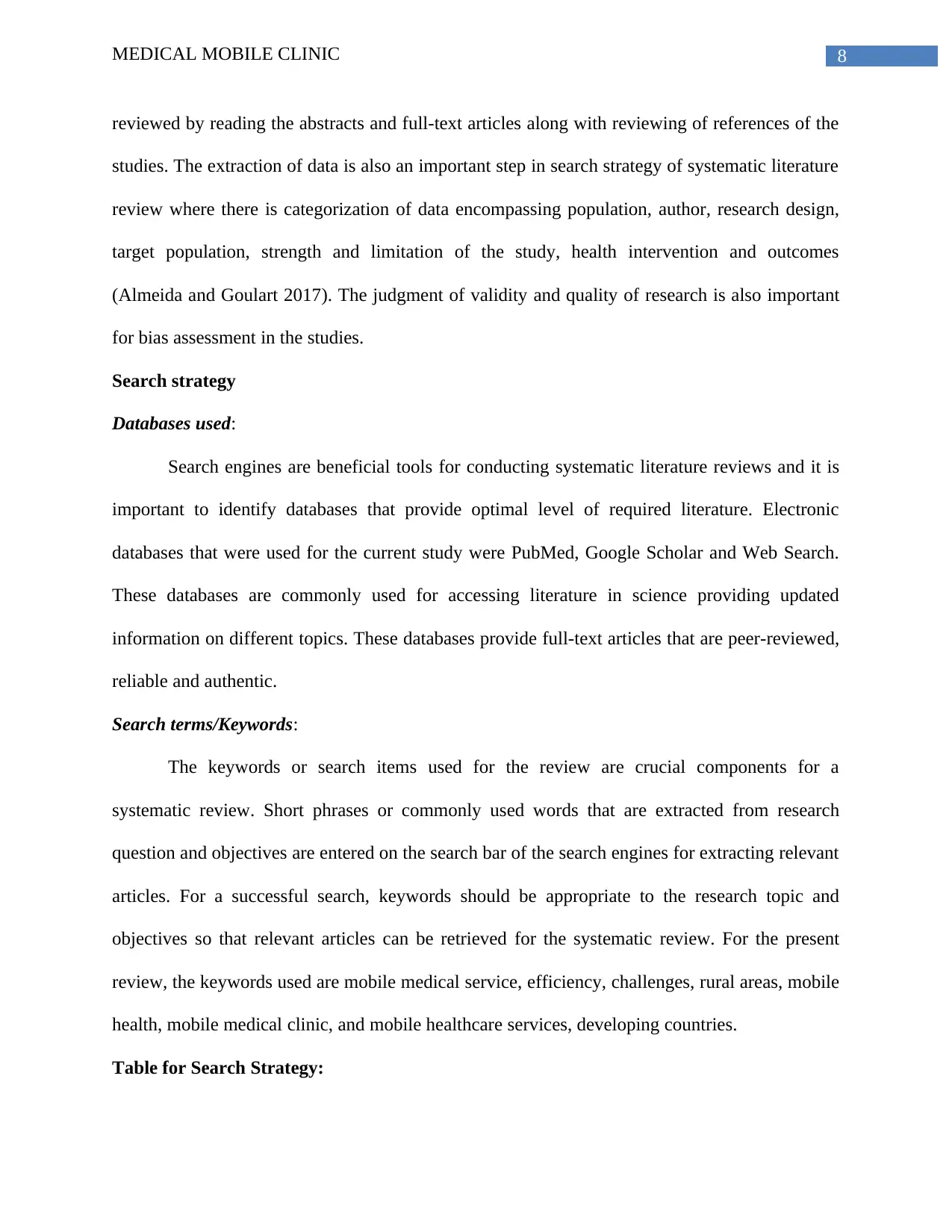
8MEDICAL MOBILE CLINIC
reviewed by reading the abstracts and full-text articles along with reviewing of references of the
studies. The extraction of data is also an important step in search strategy of systematic literature
review where there is categorization of data encompassing population, author, research design,
target population, strength and limitation of the study, health intervention and outcomes
(Almeida and Goulart 2017). The judgment of validity and quality of research is also important
for bias assessment in the studies.
Search strategy
Databases used:
Search engines are beneficial tools for conducting systematic literature reviews and it is
important to identify databases that provide optimal level of required literature. Electronic
databases that were used for the current study were PubMed, Google Scholar and Web Search.
These databases are commonly used for accessing literature in science providing updated
information on different topics. These databases provide full-text articles that are peer-reviewed,
reliable and authentic.
Search terms/Keywords:
The keywords or search items used for the review are crucial components for a
systematic review. Short phrases or commonly used words that are extracted from research
question and objectives are entered on the search bar of the search engines for extracting relevant
articles. For a successful search, keywords should be appropriate to the research topic and
objectives so that relevant articles can be retrieved for the systematic review. For the present
review, the keywords used are mobile medical service, efficiency, challenges, rural areas, mobile
health, mobile medical clinic, and mobile healthcare services, developing countries.
Table for Search Strategy:
reviewed by reading the abstracts and full-text articles along with reviewing of references of the
studies. The extraction of data is also an important step in search strategy of systematic literature
review where there is categorization of data encompassing population, author, research design,
target population, strength and limitation of the study, health intervention and outcomes
(Almeida and Goulart 2017). The judgment of validity and quality of research is also important
for bias assessment in the studies.
Search strategy
Databases used:
Search engines are beneficial tools for conducting systematic literature reviews and it is
important to identify databases that provide optimal level of required literature. Electronic
databases that were used for the current study were PubMed, Google Scholar and Web Search.
These databases are commonly used for accessing literature in science providing updated
information on different topics. These databases provide full-text articles that are peer-reviewed,
reliable and authentic.
Search terms/Keywords:
The keywords or search items used for the review are crucial components for a
systematic review. Short phrases or commonly used words that are extracted from research
question and objectives are entered on the search bar of the search engines for extracting relevant
articles. For a successful search, keywords should be appropriate to the research topic and
objectives so that relevant articles can be retrieved for the systematic review. For the present
review, the keywords used are mobile medical service, efficiency, challenges, rural areas, mobile
health, mobile medical clinic, and mobile healthcare services, developing countries.
Table for Search Strategy:
⊘ This is a preview!⊘
Do you want full access?
Subscribe today to unlock all pages.

Trusted by 1+ million students worldwide
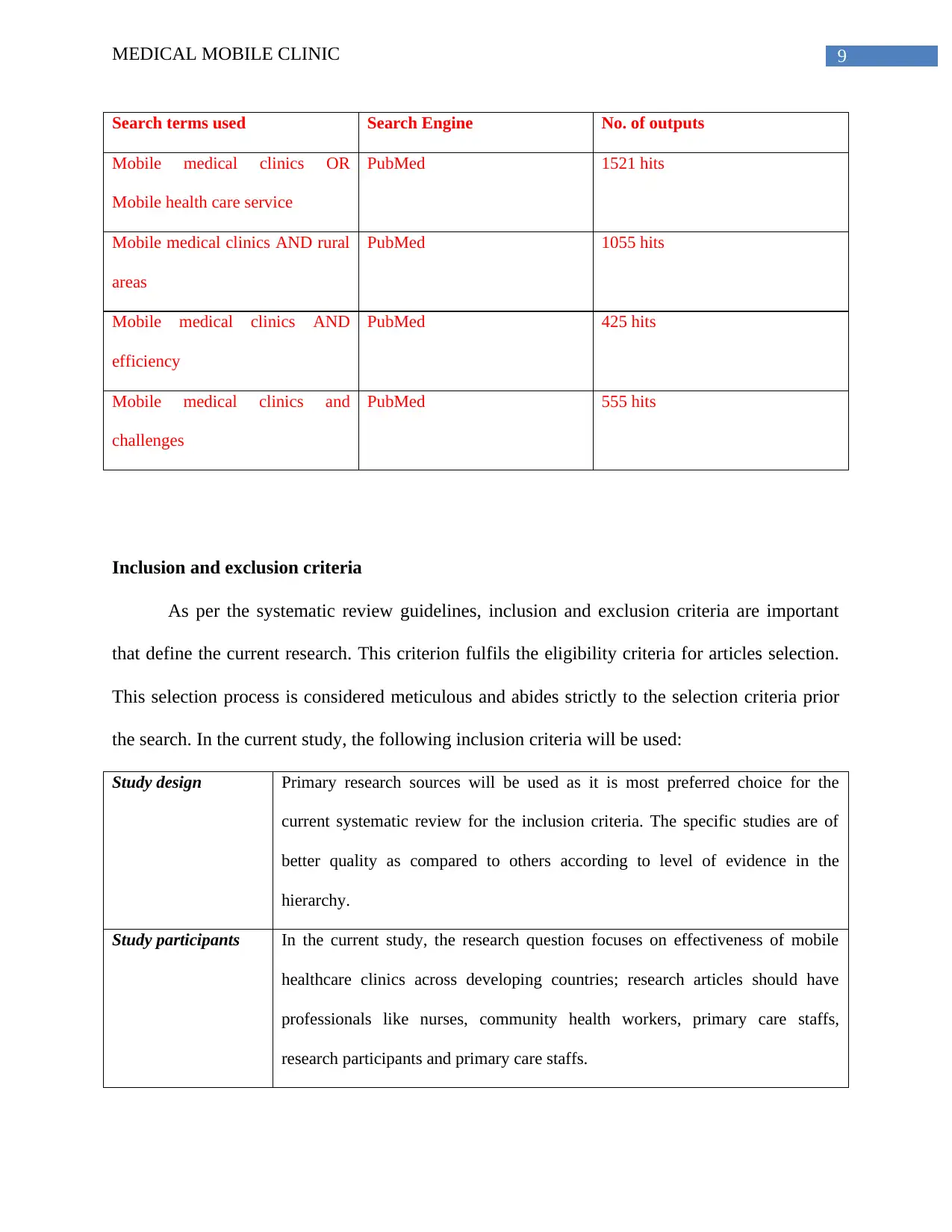
9MEDICAL MOBILE CLINIC
Search terms used Search Engine No. of outputs
Mobile medical clinics OR
Mobile health care service
PubMed 1521 hits
Mobile medical clinics AND rural
areas
PubMed 1055 hits
Mobile medical clinics AND
efficiency
PubMed 425 hits
Mobile medical clinics and
challenges
PubMed 555 hits
Inclusion and exclusion criteria
As per the systematic review guidelines, inclusion and exclusion criteria are important
that define the current research. This criterion fulfils the eligibility criteria for articles selection.
This selection process is considered meticulous and abides strictly to the selection criteria prior
the search. In the current study, the following inclusion criteria will be used:
Study design Primary research sources will be used as it is most preferred choice for the
current systematic review for the inclusion criteria. The specific studies are of
better quality as compared to others according to level of evidence in the
hierarchy.
Study participants In the current study, the research question focuses on effectiveness of mobile
healthcare clinics across developing countries; research articles should have
professionals like nurses, community health workers, primary care staffs,
research participants and primary care staffs.
Search terms used Search Engine No. of outputs
Mobile medical clinics OR
Mobile health care service
PubMed 1521 hits
Mobile medical clinics AND rural
areas
PubMed 1055 hits
Mobile medical clinics AND
efficiency
PubMed 425 hits
Mobile medical clinics and
challenges
PubMed 555 hits
Inclusion and exclusion criteria
As per the systematic review guidelines, inclusion and exclusion criteria are important
that define the current research. This criterion fulfils the eligibility criteria for articles selection.
This selection process is considered meticulous and abides strictly to the selection criteria prior
the search. In the current study, the following inclusion criteria will be used:
Study design Primary research sources will be used as it is most preferred choice for the
current systematic review for the inclusion criteria. The specific studies are of
better quality as compared to others according to level of evidence in the
hierarchy.
Study participants In the current study, the research question focuses on effectiveness of mobile
healthcare clinics across developing countries; research articles should have
professionals like nurses, community health workers, primary care staffs,
research participants and primary care staffs.
Paraphrase This Document
Need a fresh take? Get an instant paraphrase of this document with our AI Paraphraser
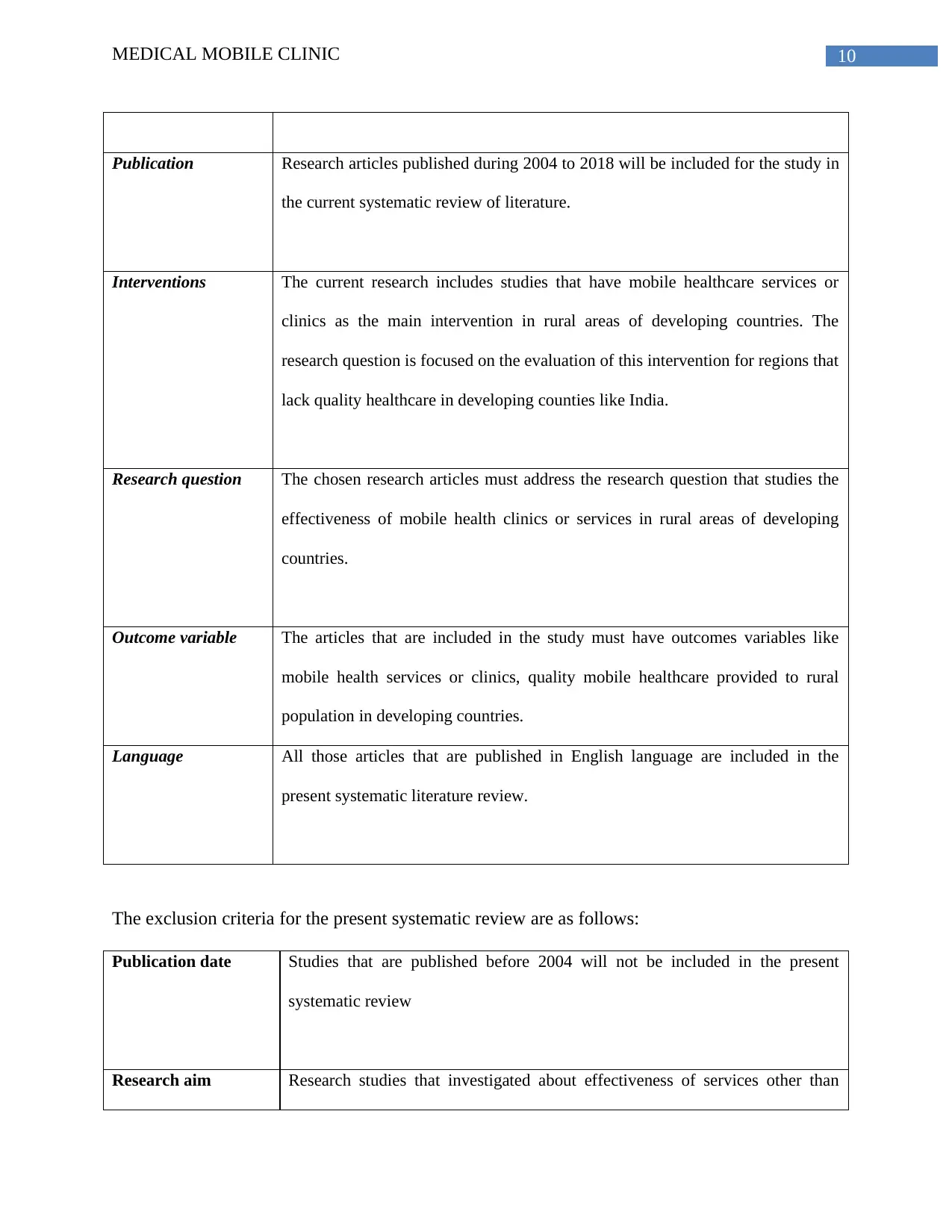
10MEDICAL MOBILE CLINIC
Publication Research articles published during 2004 to 2018 will be included for the study in
the current systematic review of literature.
Interventions The current research includes studies that have mobile healthcare services or
clinics as the main intervention in rural areas of developing countries. The
research question is focused on the evaluation of this intervention for regions that
lack quality healthcare in developing counties like India.
Research question The chosen research articles must address the research question that studies the
effectiveness of mobile health clinics or services in rural areas of developing
countries.
Outcome variable The articles that are included in the study must have outcomes variables like
mobile health services or clinics, quality mobile healthcare provided to rural
population in developing countries.
Language All those articles that are published in English language are included in the
present systematic literature review.
The exclusion criteria for the present systematic review are as follows:
Publication date Studies that are published before 2004 will not be included in the present
systematic review
Research aim Research studies that investigated about effectiveness of services other than
Publication Research articles published during 2004 to 2018 will be included for the study in
the current systematic review of literature.
Interventions The current research includes studies that have mobile healthcare services or
clinics as the main intervention in rural areas of developing countries. The
research question is focused on the evaluation of this intervention for regions that
lack quality healthcare in developing counties like India.
Research question The chosen research articles must address the research question that studies the
effectiveness of mobile health clinics or services in rural areas of developing
countries.
Outcome variable The articles that are included in the study must have outcomes variables like
mobile health services or clinics, quality mobile healthcare provided to rural
population in developing countries.
Language All those articles that are published in English language are included in the
present systematic literature review.
The exclusion criteria for the present systematic review are as follows:
Publication date Studies that are published before 2004 will not be included in the present
systematic review
Research aim Research studies that investigated about effectiveness of services other than
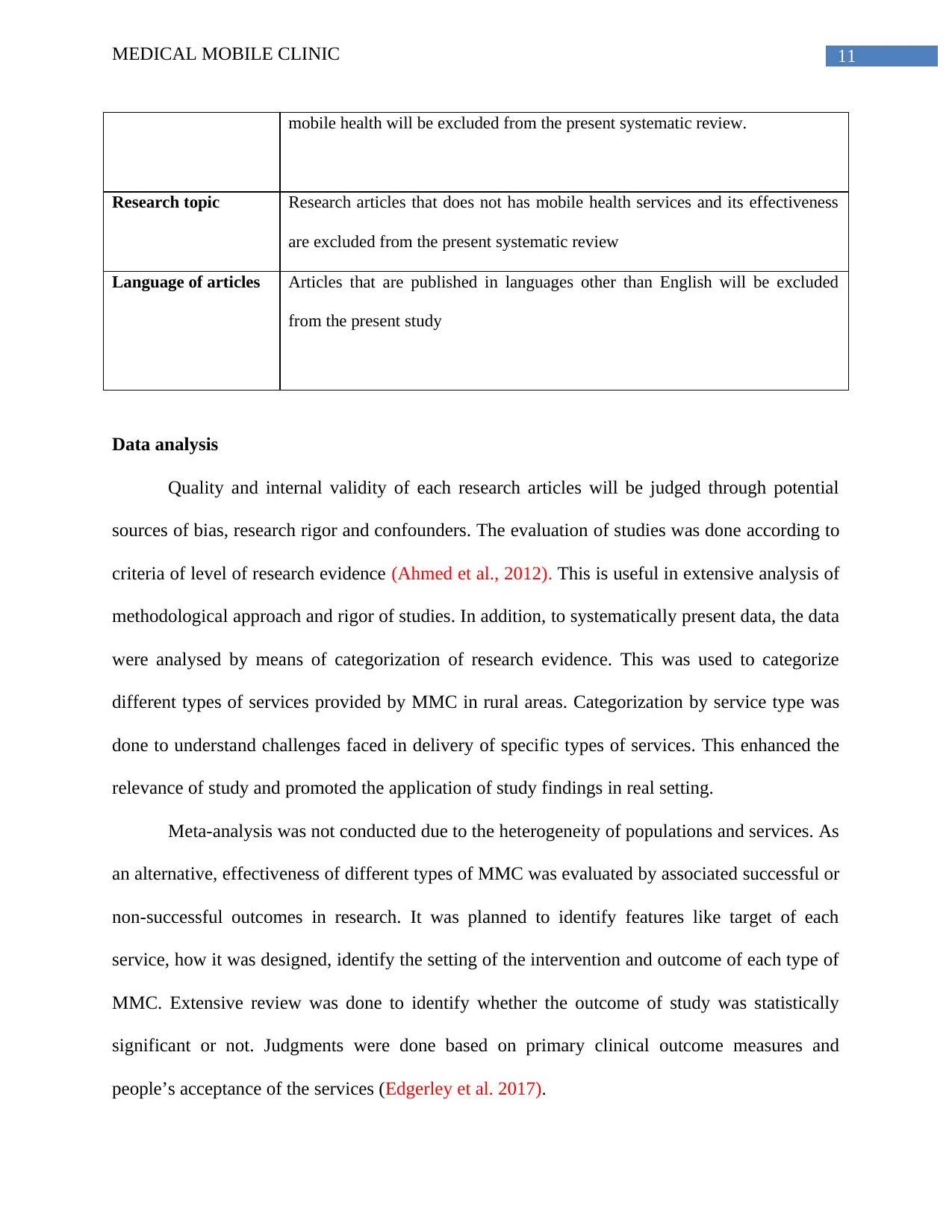
11MEDICAL MOBILE CLINIC
mobile health will be excluded from the present systematic review.
Research topic Research articles that does not has mobile health services and its effectiveness
are excluded from the present systematic review
Language of articles Articles that are published in languages other than English will be excluded
from the present study
Data analysis
Quality and internal validity of each research articles will be judged through potential
sources of bias, research rigor and confounders. The evaluation of studies was done according to
criteria of level of research evidence (Ahmed et al., 2012). This is useful in extensive analysis of
methodological approach and rigor of studies. In addition, to systematically present data, the data
were analysed by means of categorization of research evidence. This was used to categorize
different types of services provided by MMC in rural areas. Categorization by service type was
done to understand challenges faced in delivery of specific types of services. This enhanced the
relevance of study and promoted the application of study findings in real setting.
Meta-analysis was not conducted due to the heterogeneity of populations and services. As
an alternative, effectiveness of different types of MMC was evaluated by associated successful or
non-successful outcomes in research. It was planned to identify features like target of each
service, how it was designed, identify the setting of the intervention and outcome of each type of
MMC. Extensive review was done to identify whether the outcome of study was statistically
significant or not. Judgments were done based on primary clinical outcome measures and
people’s acceptance of the services (Edgerley et al. 2017).
mobile health will be excluded from the present systematic review.
Research topic Research articles that does not has mobile health services and its effectiveness
are excluded from the present systematic review
Language of articles Articles that are published in languages other than English will be excluded
from the present study
Data analysis
Quality and internal validity of each research articles will be judged through potential
sources of bias, research rigor and confounders. The evaluation of studies was done according to
criteria of level of research evidence (Ahmed et al., 2012). This is useful in extensive analysis of
methodological approach and rigor of studies. In addition, to systematically present data, the data
were analysed by means of categorization of research evidence. This was used to categorize
different types of services provided by MMC in rural areas. Categorization by service type was
done to understand challenges faced in delivery of specific types of services. This enhanced the
relevance of study and promoted the application of study findings in real setting.
Meta-analysis was not conducted due to the heterogeneity of populations and services. As
an alternative, effectiveness of different types of MMC was evaluated by associated successful or
non-successful outcomes in research. It was planned to identify features like target of each
service, how it was designed, identify the setting of the intervention and outcome of each type of
MMC. Extensive review was done to identify whether the outcome of study was statistically
significant or not. Judgments were done based on primary clinical outcome measures and
people’s acceptance of the services (Edgerley et al. 2017).
⊘ This is a preview!⊘
Do you want full access?
Subscribe today to unlock all pages.

Trusted by 1+ million students worldwide
1 out of 48
Related Documents
Your All-in-One AI-Powered Toolkit for Academic Success.
+13062052269
info@desklib.com
Available 24*7 on WhatsApp / Email
![[object Object]](/_next/static/media/star-bottom.7253800d.svg)
Unlock your academic potential
Copyright © 2020–2025 A2Z Services. All Rights Reserved. Developed and managed by ZUCOL.





